Abstract
Sulfate reducers and related organisms which had previously been found to reduce Fe(III) with H2 or organic electron donors oxidized S0 to sulfate when Mn(IV) was provided as an electron acceptor. Organisms catalyzing this reaction in washed cell suspensions included Desulfovibrio desulfuricans, Desulfomicrobium baculatum, Desulfobacterium autotrophicum, Desulfuromonas acetoxidans, and Geobacter metallireducens. These organisms produced little or no sulfate from S0 with Fe(III) as a potential electron acceptor or in the absence of an electron acceptor. In detailed studies with Desulfovibrio desulfuricans, the stoichiometry of sulfate and Mn(II) production was consistent with the reaction S0 + 3 MnO2 + 4H+→SO42- + 3Mn(II) + 2H2O. None of the organisms evaluated could be grown with S0 as the sole electron donor and Mn(IV) as the electron acceptor. In contrast to the other sulfate reducers evaluated, Desulfobulbus propionicus produced sulfate from S0 in the absence of an electron acceptor and Fe(III) oxide stimulated sulfate production. Sulfide also accumulated in the absence of Mn(IV) or Fe(III). The stoichiometry of sulfate and sulfide production indicated that Desulfobulbus propionicus disproportionates S0 as follows: 4S0 + 4H2O→SO42- + 3HS- + 5 H+. Growth of Desulfobulbus propionicus with S0 as the electron donor and Fe(III) as a sulfide sink and/or electron acceptor was very slow. The S0 oxidation coupled to Mn(IV) reduction described here provides a potential explanation for the Mn(IV)-dependent sulfate production that previous studies have observed in anoxic marine sediments. Desulfobulbus propionicus is the first example of a pure culture known to disproportionate S0.
Full text
PDF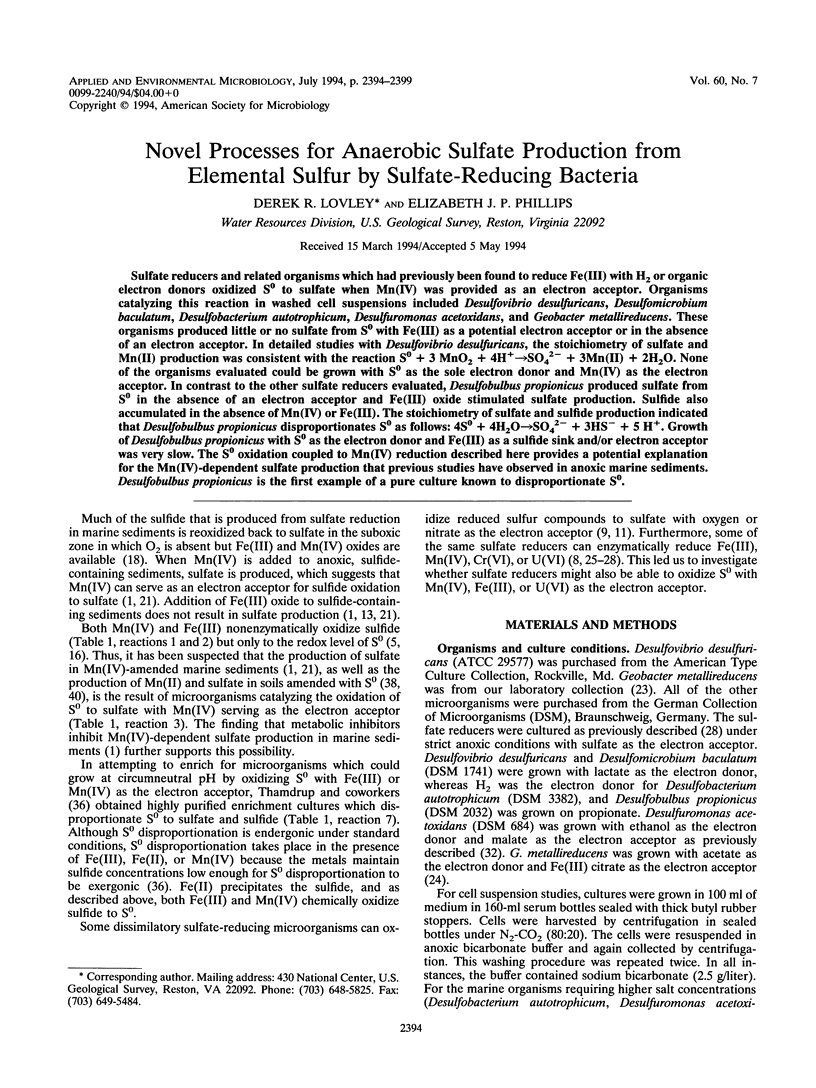
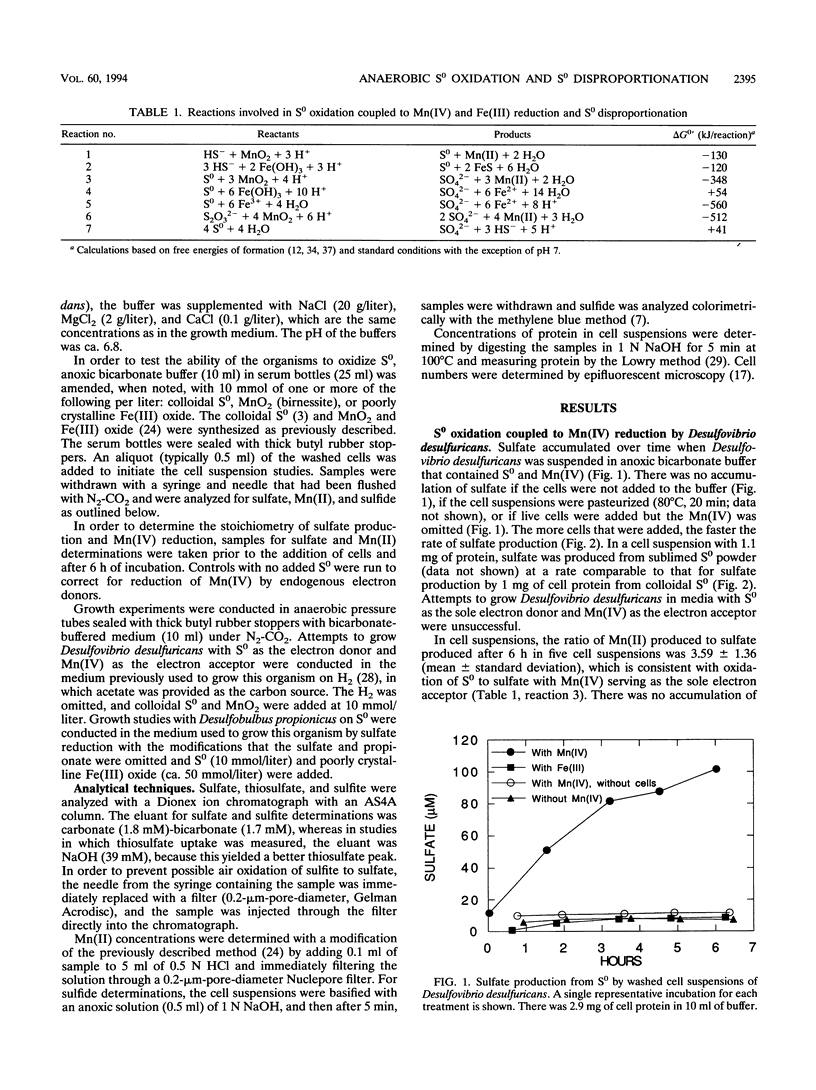
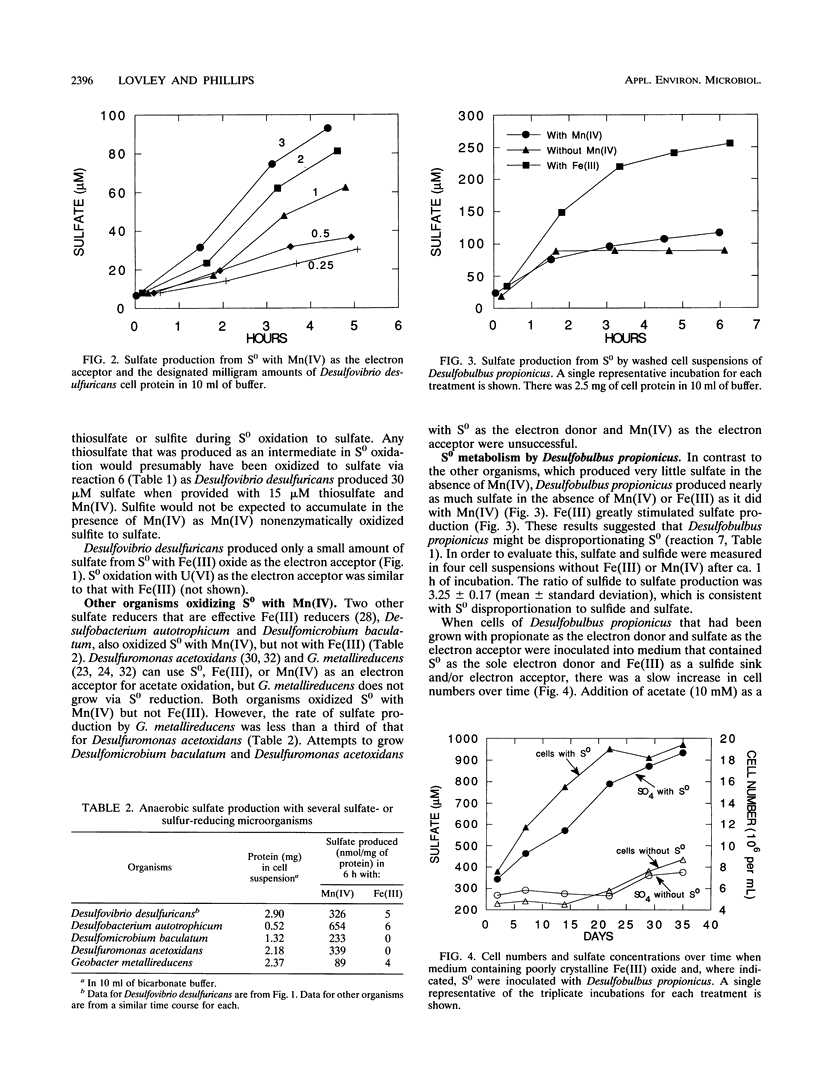
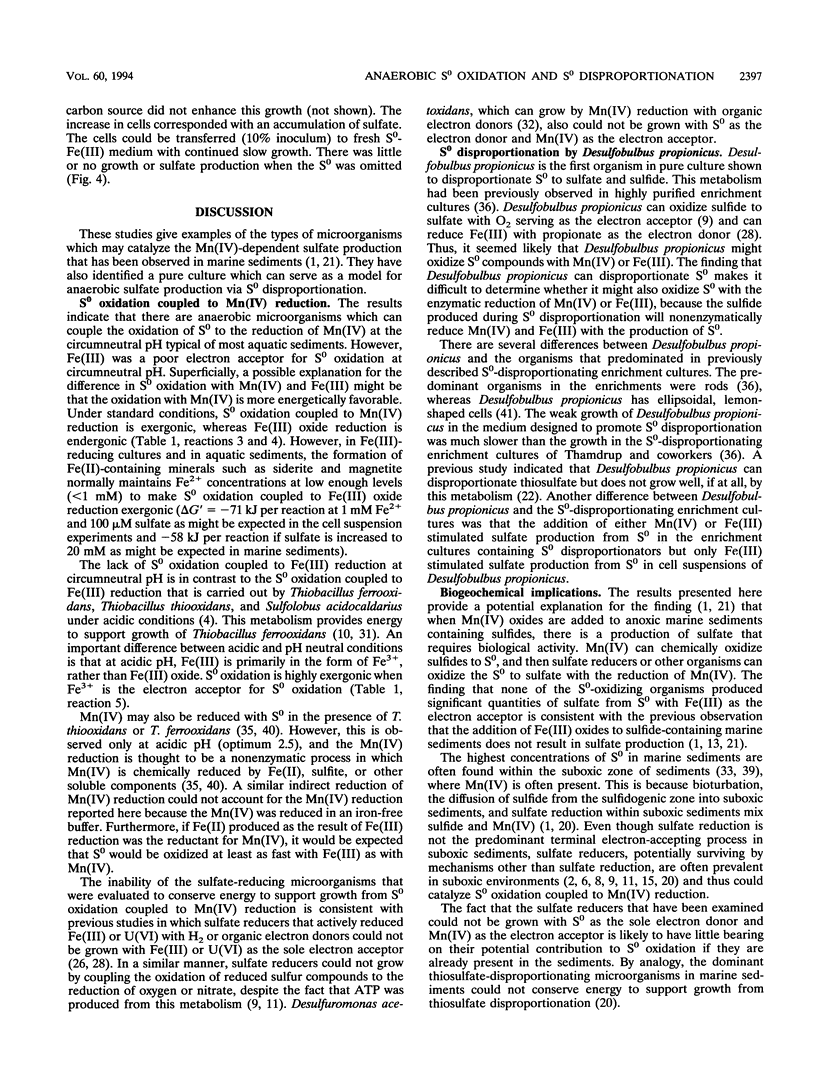
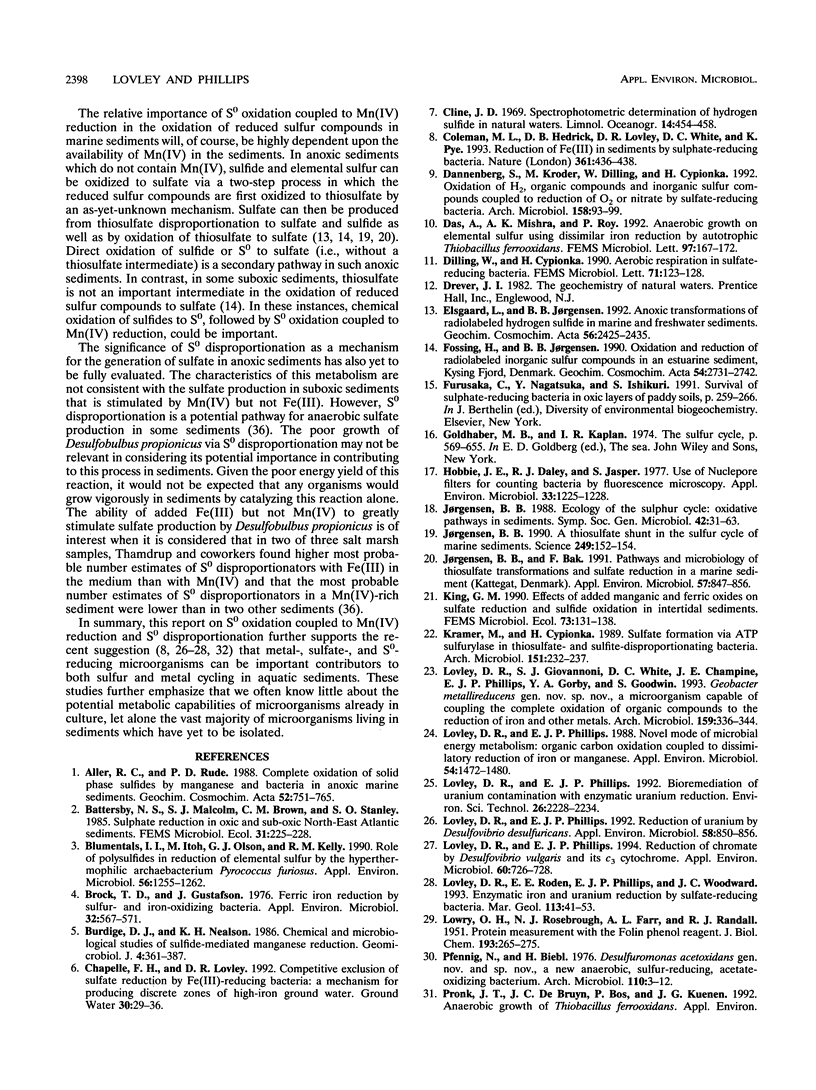
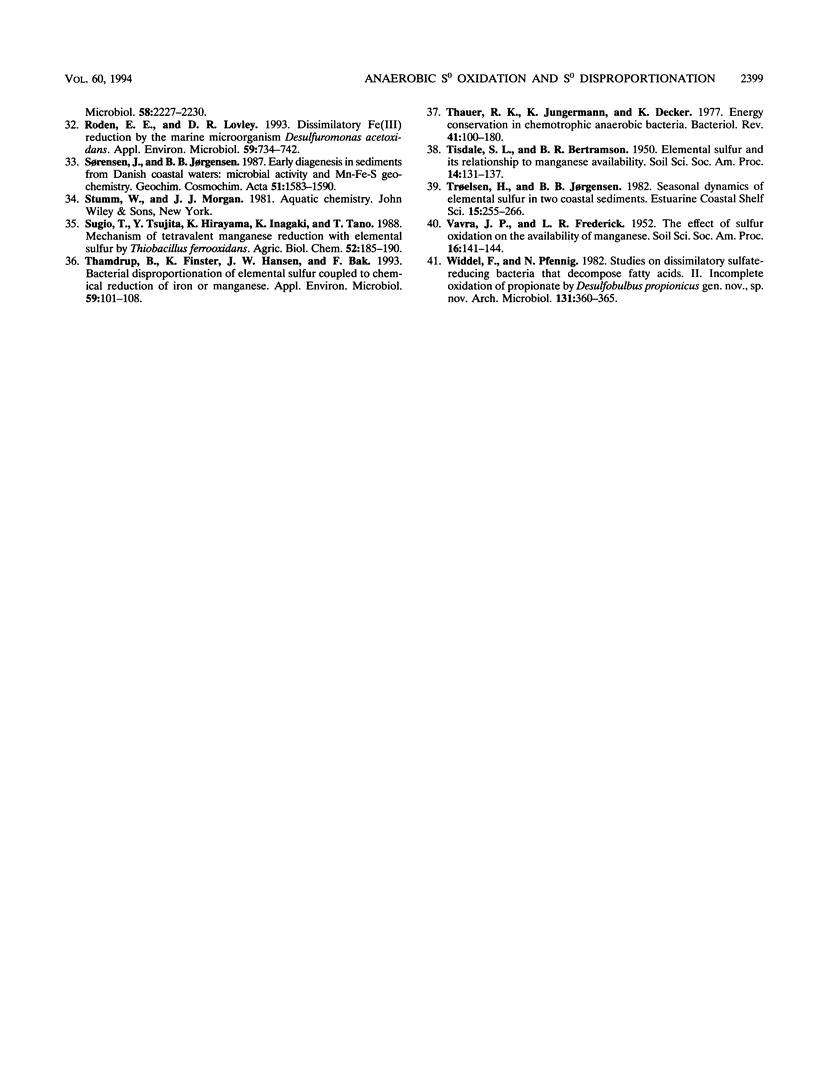
Selected References
These references are in PubMed. This may not be the complete list of references from this article.
- Blumentals I. I., Itoh M., Olson G. J., Kelly R. M. Role of Polysulfides in Reduction of Elemental Sulfur by the Hyperthermophilic Archaebacterium Pyrococcus furiosus. Appl Environ Microbiol. 1990 May;56(5):1255–1262. doi: 10.1128/aem.56.5.1255-1262.1990. [DOI] [PMC free article] [PubMed] [Google Scholar]
- Brock T. D., Gustafson J. Ferric iron reduction by sulfur- and iron-oxidizing bacteria. Appl Environ Microbiol. 1976 Oct;32(4):567–571. doi: 10.1128/aem.32.4.567-571.1976. [DOI] [PMC free article] [PubMed] [Google Scholar]
- Hobbie J. E., Daley R. J., Jasper S. Use of nuclepore filters for counting bacteria by fluorescence microscopy. Appl Environ Microbiol. 1977 May;33(5):1225–1228. doi: 10.1128/aem.33.5.1225-1228.1977. [DOI] [PMC free article] [PubMed] [Google Scholar]
- Jørgensen B. B. A thiosulfate shunt in the sulfur cycle of marine sediments. Science. 1990 Jul 13;249(4965):152–154. doi: 10.1126/science.249.4965.152. [DOI] [PubMed] [Google Scholar]
- Jørgensen B. B., Bak F. Pathways and microbiology of thiosulfate transformations and sulfate reduction in a marine sediment (kattegat, denmark). Appl Environ Microbiol. 1991 Mar;57(3):847–856. doi: 10.1128/aem.57.3.847-856.1991. [DOI] [PMC free article] [PubMed] [Google Scholar]
- LOWRY O. H., ROSEBROUGH N. J., FARR A. L., RANDALL R. J. Protein measurement with the Folin phenol reagent. J Biol Chem. 1951 Nov;193(1):265–275. [PubMed] [Google Scholar]
- Lovley D. R., Giovannoni S. J., White D. C., Champine J. E., Phillips E. J., Gorby Y. A., Goodwin S. Geobacter metallireducens gen. nov. sp. nov., a microorganism capable of coupling the complete oxidation of organic compounds to the reduction of iron and other metals. Arch Microbiol. 1993;159(4):336–344. doi: 10.1007/BF00290916. [DOI] [PubMed] [Google Scholar]
- Lovley D. R., Phillips E. J. Novel mode of microbial energy metabolism: organic carbon oxidation coupled to dissimilatory reduction of iron or manganese. Appl Environ Microbiol. 1988 Jun;54(6):1472–1480. doi: 10.1128/aem.54.6.1472-1480.1988. [DOI] [PMC free article] [PubMed] [Google Scholar]
- Lovley D. R., Phillips E. J. Reduction of Chromate by Desulfovibrio vulgaris and Its c(3) Cytochrome. Appl Environ Microbiol. 1994 Feb;60(2):726–728. doi: 10.1128/aem.60.2.726-728.1994. [DOI] [PMC free article] [PubMed] [Google Scholar]
- Lovley D. R., Phillips E. J. Reduction of uranium by Desulfovibrio desulfuricans. Appl Environ Microbiol. 1992 Mar;58(3):850–856. doi: 10.1128/aem.58.3.850-856.1992. [DOI] [PMC free article] [PubMed] [Google Scholar]
- Pfennig N., Biebl H. Desulfuromonas acetoxidans gen. nov. and sp. nov., a new anaerobic, sulfur-reducing, acetate-oxidizing bacterium. Arch Microbiol. 1976 Oct 11;110(1):3–12. doi: 10.1007/BF00416962. [DOI] [PubMed] [Google Scholar]
- Roden E. E., Lovley D. R. Dissimilatory Fe(III) Reduction by the Marine Microorganism Desulfuromonas acetoxidans. Appl Environ Microbiol. 1993 Mar;59(3):734–742. doi: 10.1128/aem.59.3.734-742.1993. [DOI] [PMC free article] [PubMed] [Google Scholar]
- Thamdrup B., Finster K., Hansen J. W., Bak F. Bacterial disproportionation of elemental sulfur coupled to chemical reduction of iron or manganese. Appl Environ Microbiol. 1993 Jan;59(1):101–108. doi: 10.1128/aem.59.1.101-108.1993. [DOI] [PMC free article] [PubMed] [Google Scholar]
- Thauer R. K., Jungermann K., Decker K. Energy conservation in chemotrophic anaerobic bacteria. Bacteriol Rev. 1977 Mar;41(1):100–180. doi: 10.1128/br.41.1.100-180.1977. [DOI] [PMC free article] [PubMed] [Google Scholar]


